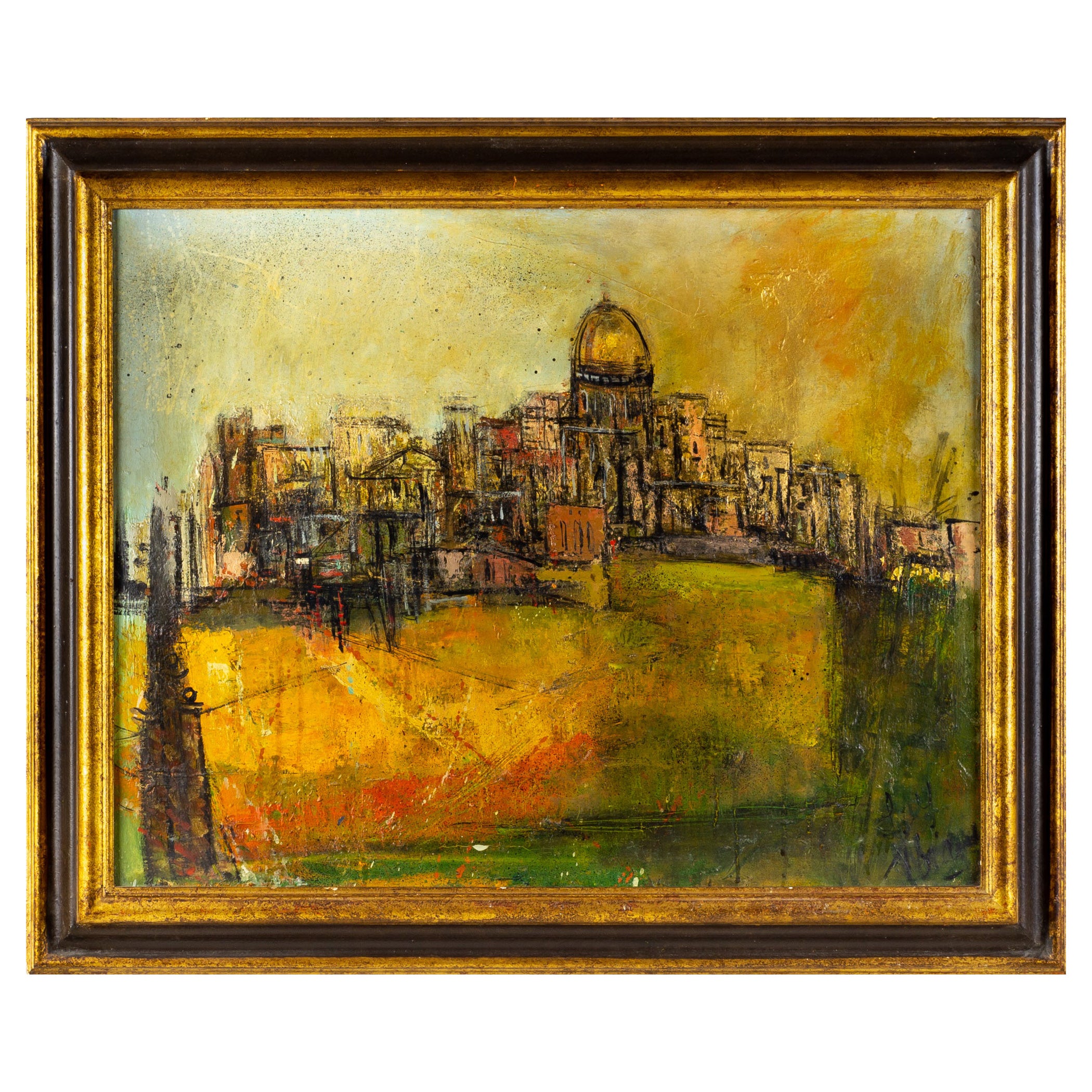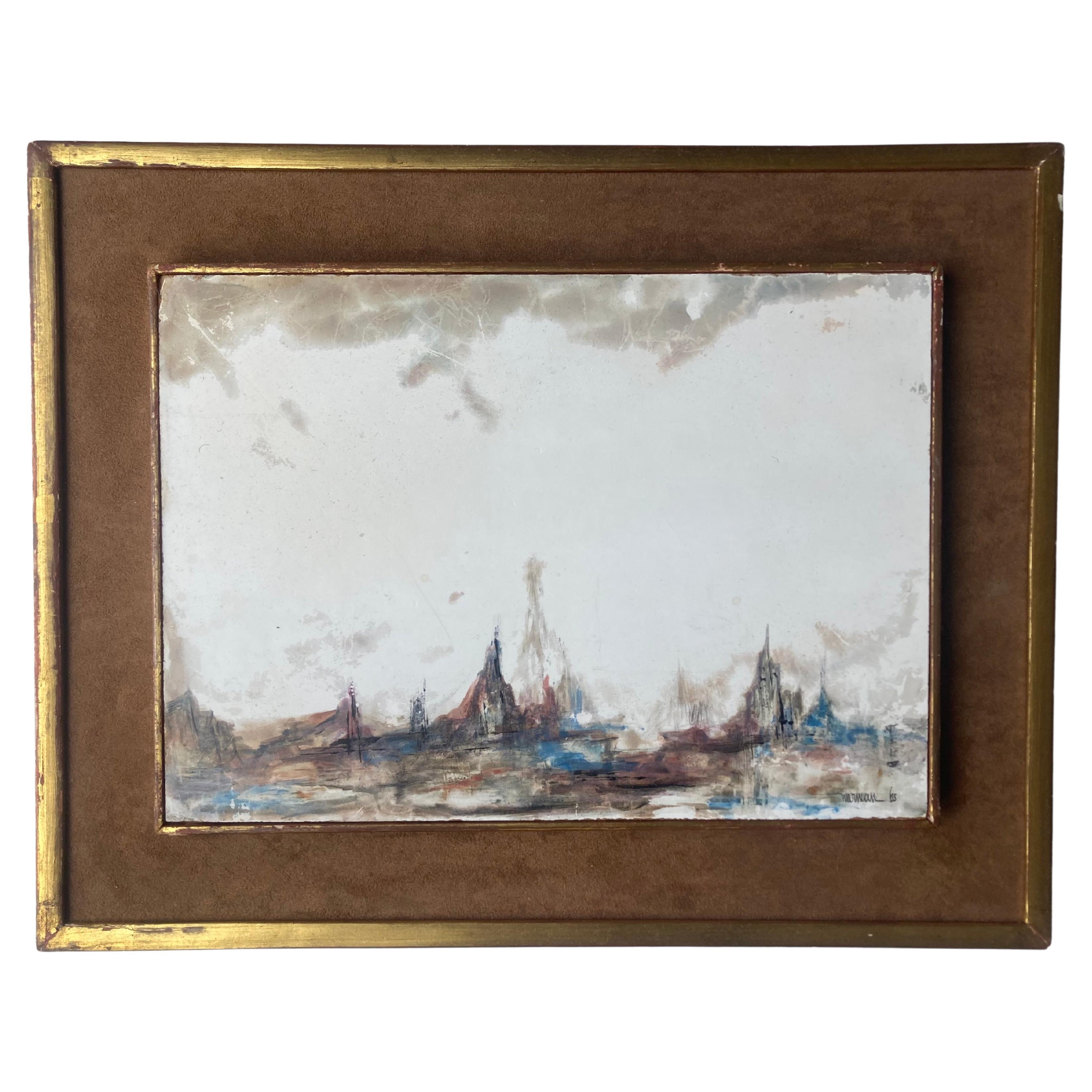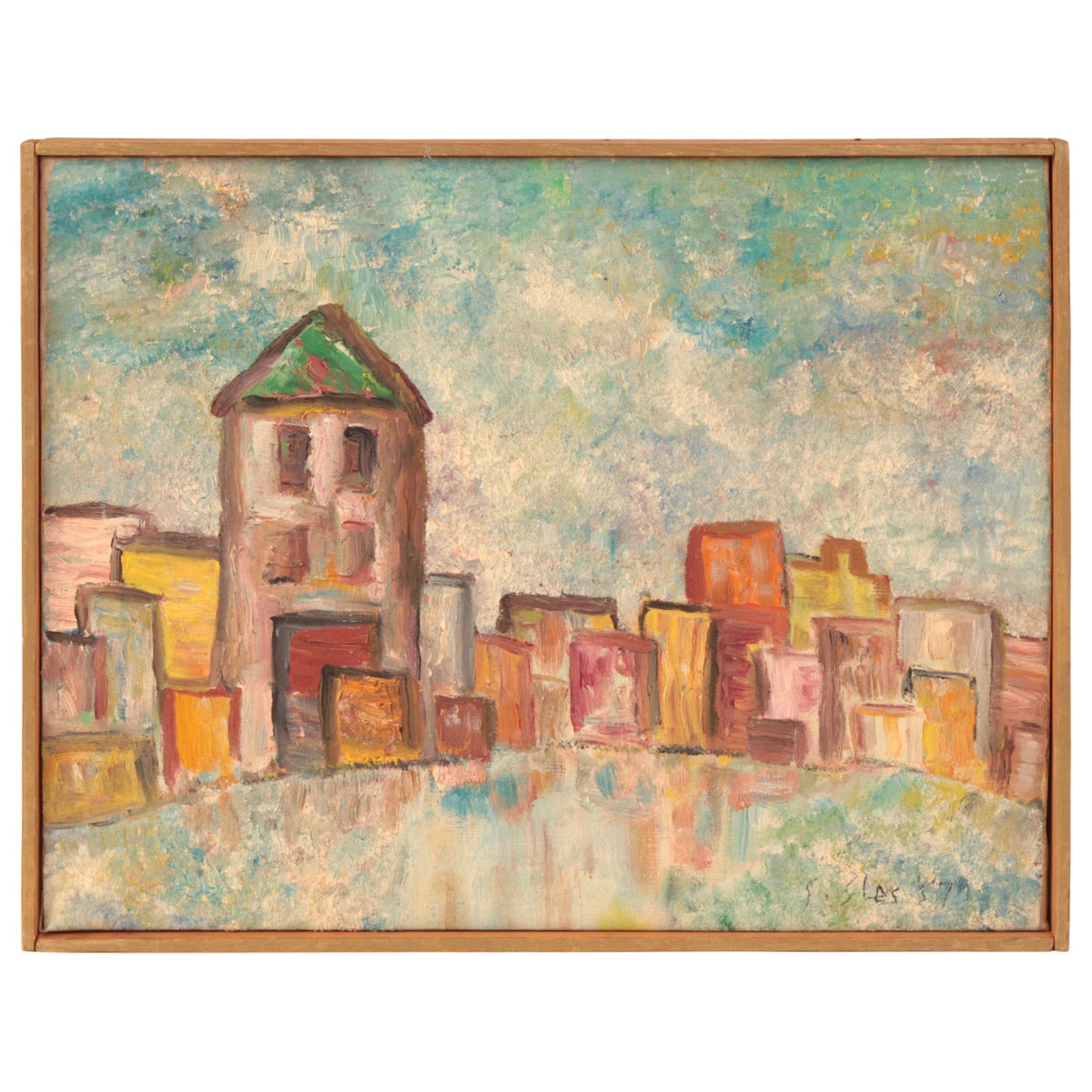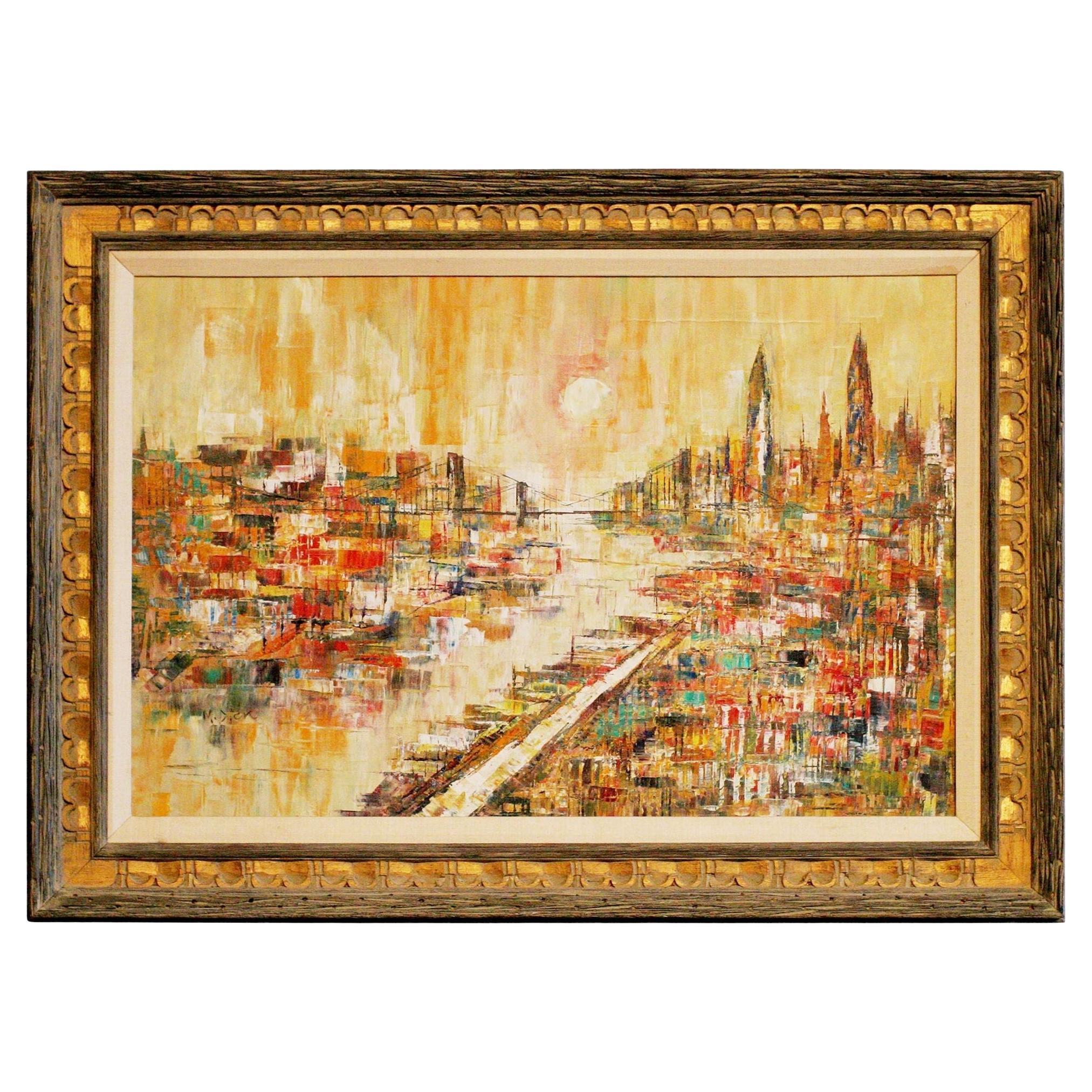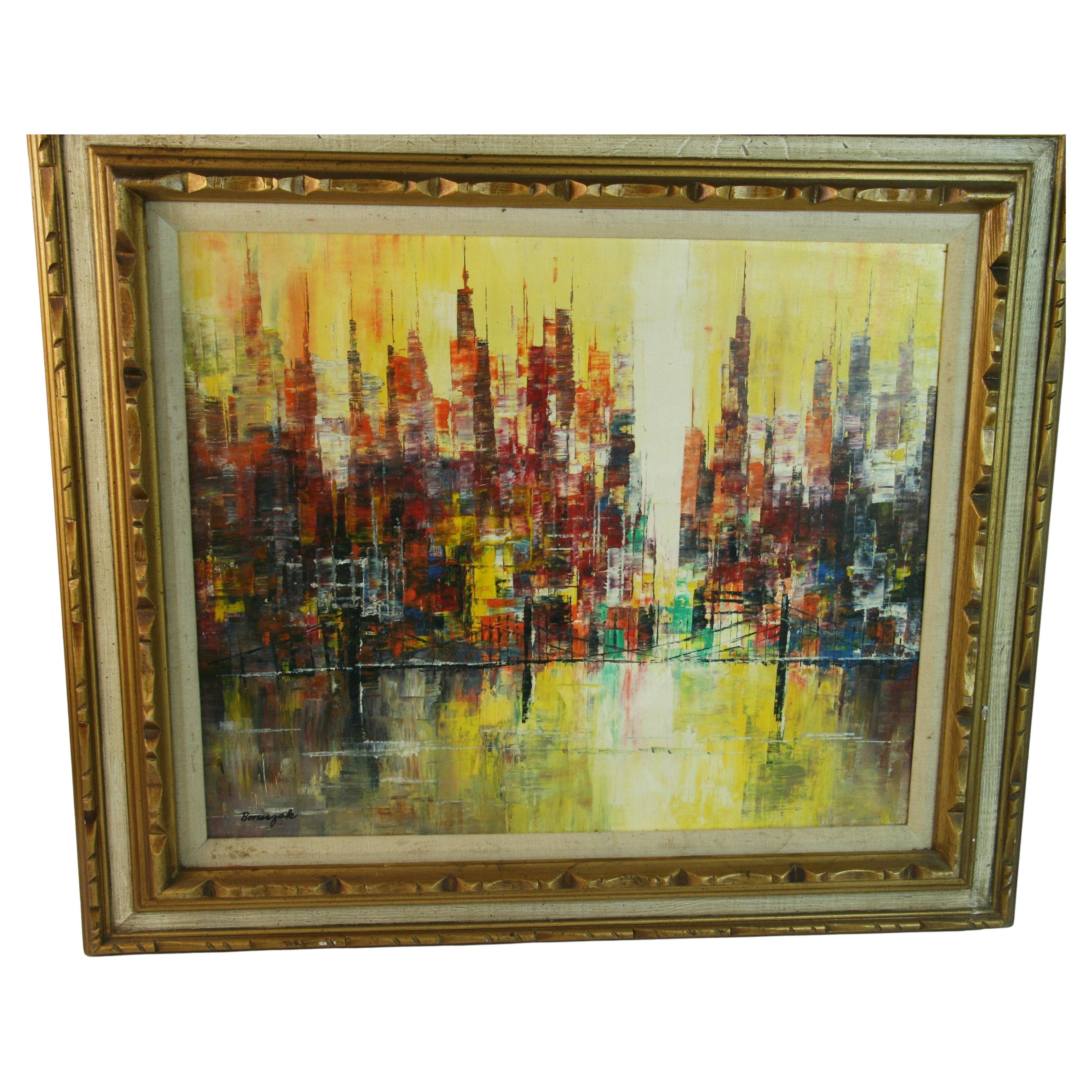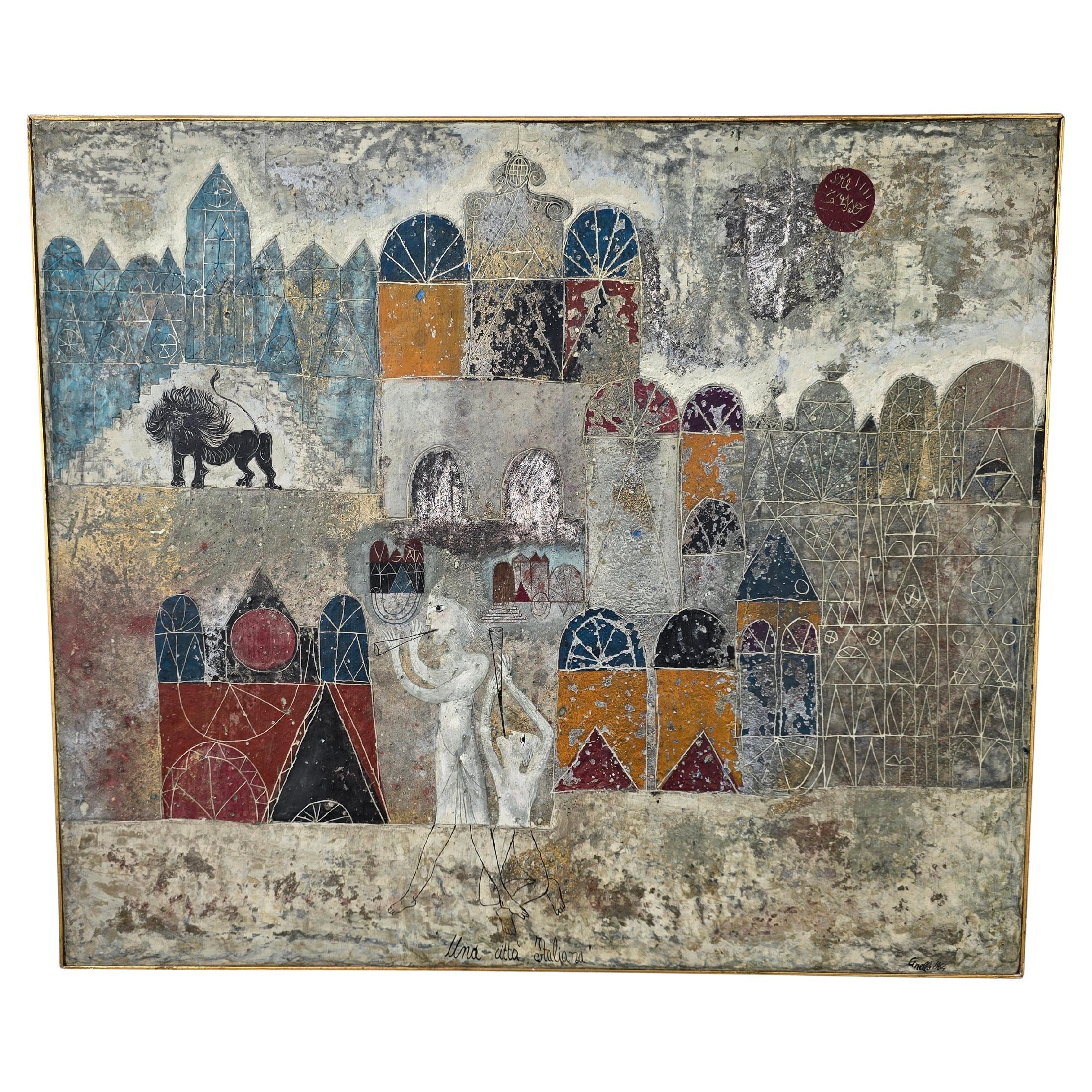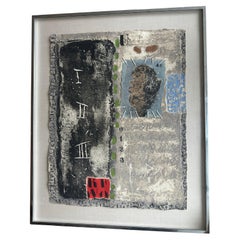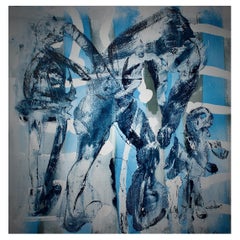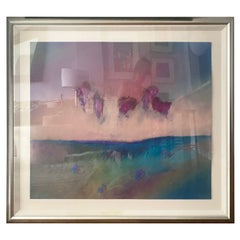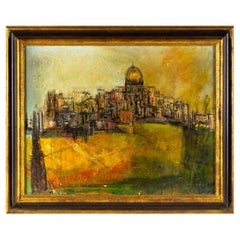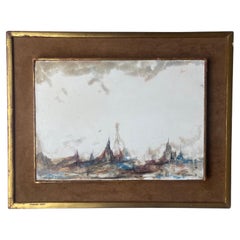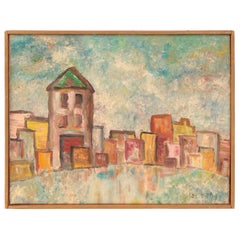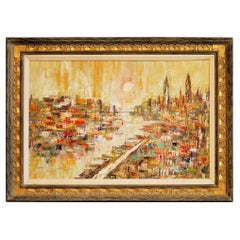Items Similar to "La Salute" Cityscape by Lazzaro Donati - Oil on Board
Video Loading
Want more images or videos?
Request additional images or videos from the seller
1 of 10
"La Salute" Cityscape by Lazzaro Donati - Oil on Board
$5,700
£4,368.36
€5,020.66
CA$8,005.93
A$8,960.11
CHF 4,690.30
MX$108,849.13
NOK 59,554.88
SEK 56,200.20
DKK 37,462.97
About the Item
"La Salute" is a striking oil painting by renowned Italian artist Lazzaro Donati, depicting the iconic Santa Maria della Salute church in Venice. Known for his vivid, expressionistic landscapes, Donati captures the grandeur and beauty of this Venetian landmark with his signature bold use of color and fluid, dynamic forms.
The composition is dominated by the church’s recognizable dome, which is rendered in rich green and blue hues, juxtaposed against splashes of vibrant red, orange, and yellow that energize the painting. The flowing brushstrokes evoke the sense of movement and life within the city, reflecting the powerful architectural presence of the church, which stands at the entrance to the Grand Canal in Venice. The abstracted elements around the church, including textured, gestural lines and soft curves, express Donati’s ability to fuse abstraction with the real, creating a composition that feels both monumental and deeply personal.
Donati, born in Florence in 1926, was deeply influenced by the classical Italian tradition, yet his works also incorporate elements of modern abstraction and European avant-garde movements. Throughout his career, he sought to capture not just the physical form of his subjects, but their emotional essence. His fascination with Venetian architecture, particularly the Salute Church, led to numerous representations of this iconic structure throughout his career, each infused with his poetic and dynamic interpretation of the city’s timeless beauty.
"La Salute" is a reflection of Donati’s unique vision of Venice, where the city’s architectural landmarks are presented not just as static buildings, but as living, breathing parts of the city’s soul. Through his expressive use of color and form, Donati brings to life the church’s monumental beauty, enveloping it in an energy that resonates with the viewer long after they have looked away.
This piece is a rare and exceptional example of Donati’s urban landscapes, showcasing his masterful technique, poetic vision, and ability to infuse traditional subjects with modernist energy. It’s an outstanding addition to any collection of 20th-century Italian art and a testament to the enduring beauty of Venice.
- Creator:Lazzaro Donati (Artist)
- Dimensions:Height: 24 in (60.96 cm)Width: 22.25 in (56.52 cm)Depth: 1 in (2.54 cm)
- Materials and Techniques:
- Place of Origin:
- Period:
- Date of Manufacture:1966
- Condition:Wear consistent with age and use.
- Seller Location:New York City, NY
- Reference Number:1stDibs: LU5191145013522
Farrago Design Inc
Farrago Design is a New York–based design studio creating collectible furniture and home accessories that marry craftsmanship with contemporary design. Founded with a mission to revive traditional techniques in a modern context, Farrago works directly with artisans to create heirloom-quality pieces using materials such as hand-carved bone, horn, sand-cast metals, and semi-precious stones. Our work sits at the crossroads of art and function and includes three collections. The Sand Collection features intricately hand-cut bone and horn inlays set into wood and sealed with a water-based resin. The patterns—subtle, organic, and architectural—are fully customizable, making these pieces ideal for bespoke residential and hospitality projects.
The Water Collection explores the sculptural potential of metal, using sand-casting techniques to create fluid, one-of-a-kind forms in Bronze, Aluminum, Brass etc, From side tables to lighting, each piece is cast in a single-use mold, making it truly unique adding texture and movement.
The Earth Collection celebrates the raw beauty of the natural world, incorporating hand-set minerals like pyrite, selenite, and semi-precious stones into bold, luxurious designs. Every piece is made to order and can be customized in scale, material, and finish. We welcome trade inquiries and collaborate closely with designers to develop bespoke products whether for a modern loft, boutique hotel, or superyacht interior.
About the Seller
5.0
Vetted Professional Seller
Every seller passes strict standards for authenticity and reliability
Established in 2003
1stDibs seller since 2020
12 sales on 1stDibs
- ShippingRetrieving quote...Shipping from: New York, NY
- Return Policy
Authenticity Guarantee
In the unlikely event there’s an issue with an item’s authenticity, contact us within 1 year for a full refund. DetailsMoney-Back Guarantee
If your item is not as described, is damaged in transit, or does not arrive, contact us within 7 days for a full refund. Details24-Hour Cancellation
You have a 24-hour grace period in which to reconsider your purchase, with no questions asked.Vetted Professional Sellers
Our world-class sellers must adhere to strict standards for service and quality, maintaining the integrity of our listings.Price-Match Guarantee
If you find that a seller listed the same item for a lower price elsewhere, we’ll match it.Trusted Global Delivery
Our best-in-class carrier network provides specialized shipping options worldwide, including custom delivery.More From This Seller
View AllSigned color aquatint, etching, carborundum, and collage by James Coignard
Located in New York City, NY
This dynamic mixed-media by James Coignard, exemplifies the artist’s innovative approach to abstraction. A perfect fusion of color aquatint, etching, carborundum, and collage, the pi...
Category
Vintage 1970s Paintings
Materials
Thread, Paper
Mixed Media Painting by Steven Colucci, Sea Series
By Jackson Pollock
Located in New York City, NY
Steven Colucci’s iconoclastic approach to performance and the visual arts have not only long blurred the boundaries between these disciplines, but have challenged its most basic assumptions. The title of this show references a most rudimentary dance move -- the plié -- and our assumptions of what to expect in relation to this. Also the suggestion that we can simply press a button and a preconceived outcome will be courteously delivered -- a form of prefabricated belief in itself. Steven Colucci’s artwork turns such basic assumptions on their heads. Finding early inspiration in the New York school of abstract expressionists such as Jackson Pollock with his action painting, and then further by his professor -- a then young Vito Acconci while studying at the School
of Visual Arts, Steven Colucci went from exploring the raw existentialist experimentation of New York’s early painting and performance scenes, to investigating the other end of the spectrum -- the rigorously measured and controlled disciplines of pantomime and ballet; studying in Paris under the tutelage of world-famous Marcelle Marceau, and engaging with the concepts of dramatic movement pioneer and intellectual Etienne Decroux. Colucci has explained the difference between the extremes of pantomime and dance as being that pantomime forces movement via an internal capacity -- movement directed inward to the core of one’s self -- a source requiring extreme mental and physical control. Dance by contrast is an external expression; likewise requiring great precision, although instead an extension of self or sentiment that projects outwardly. While such historical ‘movement’ disciplines serve as foundation blocks for Steven’s artistic explorations, it is the realm in between that he is best known for his contributions -- an experimental movement and performance art that simultaneously honors, yet defiantly refutes tradition; rejecting a compartmentalization regarding art and movement, yet incorporating its elements into his own brand of experimental pastiche. Colucci’s performance works manifest
as eerily candy-coated and familiar, yet incorporate unexpected jags of the uncanny throughout, exploiting a sort of coulrophobia in the viewer; an exploration of a cumulative artifice that binds human nature against its darker tendencies; highlighting traditions of artifice itself -- the fabricated systemologies that necessitate compartmentalization in the first place.
It is evident in Steven Colucci’s paintings that he has established a uniquely distinctive pictorial vocabulary; a strong allusion to -- or moreso an extension of -- his performance works. Colucci’s paintings depict a sort of kinetic spectrum, or as he refers to them “a technical expression of physicality and movement”. Whereas the French performance and visual artist Yves Klein used the human body as a “paint brush” to demarcate his paintings and thereby signify a residue of performance, Colucci’s utilization of nonsensical numbers and number sequences taken from dance scores, as well as heat-induced image abstraction depicting traces of movement likewise inform his vocabulary. In the strand of the choreographed, yet incorporating moments of chance, Colucci’s paintings represent an over arching structure; a rhythm of being and state, yet detail erratic moments -- moments that
denote a certain frailty -- the edge of human stamina. Colucci’s paintings dually represent a form of gestural abstraction -- and also the reverse of this -- a unique anthropomorphization of varying states of movement -- that sometimes present as a temperature induced color field, at others are juxtapositions of movement and depictions of physical gestural images themselves. Colucci’s use of vernacular and found materials such as cardboard evoke his mastery of set design, and also reference a sort of collective experience of urbanity and the ephemeral. Such contradictions seem to permeate not only Steven Colucci’s artwork, but also are reflected in his person -- one
who grew up in New York’s Bronx during a zeitgeist moment in visual and performing arts in the 1960s -- one who shifts with ease from happenings and experiments in New York City, to his meticulously choreographed megaproductions at Lincoln Center or starring in the Paris ballet...
Category
2010s Paintings
Materials
Acrylic
Large Modern Abstract Art Painting Signed Original Mark Dickson
By (after) Mark Rothko
Located in New York City, NY
This is an Original Mark Dickson painting and can be described as nothing short of a revelation in the realm of contemporary art. As one navigates through his vibrant interplay of colors—pinks, purples, blues, and greens—it becomes evident that his works are a bridge between abstract expression and a deep-seated Coloradan sensibility.
From afar, the paintings resonate with the raw energy and abstract impulsiveness reminiscent of Adolph Gottlieb or Mark Rothko. However, upon closer introspection, Dickson's canvas unfolds a symphony, harmoniously blending his intuitive understanding of the Colorado landscapes with an almost Rothkoesque play of color and form.
His artistry is a culmination of his academic sojourns, from the bustling art scene of Brooklyn's Pratt Institute to the scholarly corridors of the University of Denver. Yet, what stands out is his capability to transcend these teachings and manifest a unique narrative—one that reflects both the external world and the myriad landscapes of the human psyche.
The choice of medium, notably pastel mixed with watercolors, oil washes, and graphite pencil, demonstrates a tactile indulgence in his craft. It's as if he's chiseling his memories, experiences, and observations of the Coloradan terrains and skies into each canvas.
For the discerning eye, his works might also evoke the expansive color fields of Milton Avery. Yet, Dickson’s approach, particularly his relationship with color, is refreshingly instinctual, almost challenging the viewer to feel rather than dissect.
In Mark Dickson's work, we're treated to an exhilarating dance of abstract brilliance juxtaposed with the tangible and intangible memories of Colorado's landscapes. In a sense, each painting becomes an invitation—to wander, to wonder, and to immerse in the art of profound introspection.
The majority medium is pastel and a mixed media of watercolors, oil washes, and graphite pencil. Color is of primary importance to his work. His work shows the influence of artists Milton Avery(who used large areas of color) and Mark Rothko and Adolph Gottlieb (known for their work in the variations of color). Mark is fascinated with color and explores every aspect of its relationships. He feels his use of color is more intuitive versus analytical.
Mark Dickson’s paintings, prints and monotypes are represented in private, corporate and public art collections nationally.
Pratt Institute, Graduate School of Fine Arts, Brooklyn, New York, 1970
University of Denver, Graduate School of Art, MFA, Denver, Brooklyn, New York, 1973
Denver Art Museum, Colorado Annual, 1967
National Academy of Design, National Audubon Exhibition, New York
Joslin Art Museum Exhibition of Colorado artists, Omaha, Nebraska
Included in Outstanding and Noteworthy Americans, Bicentennial Edition, New York
Chicago Botanical Garden, solo exhibition, North Brook Illinois
Colorado Symphony Orchestra Association, limited-edition lithograph commission
Broadway South West department store Commission; shopping bag and print.
Award of Merit from American Institute of graphic arts, and Award of Distinction: "Creativity 86" Art Direction Magazine, New York
Stables Art Center, Taos New Mexico, Artist of Taos
Who's Who in American Art, 1990, New York
Arts Student's League of Denver, Board of Directors
O'Sullivan Art Center, Regis University solo exhibition, Denver
Britto Central Gallery, solo exhibition, São Paulo Brazil, 2003
Amarillo Art Museum, permanent collection
Amoco Oil Company, Chicago
Federal Reserve Bank, Denver
University of Colorado, permanent collection, Boulder, Colorado
Garnett Corporation headquarters, Arlington Virginia
IBM Corporation Miami Florida
Las Vegas Federal Medical Center
Kirkland Art Museum, permanent collection, Denver
Northern Trust Bank, Naples, Florida
Planes Art...
Category
1990s Paintings
Materials
Acrylic, Paint, Paper
$3,920 Sale Price
20% Off
O/C Mid-Century Abstract Figurative Painting, Signed and Dated
By Wifredo Lam
Located in New York City, NY
This striking mid-century abstract painting depicts a seated dancer rendered in a sophisticated cubist-inspired style reminiscent of Pei Yang's work, though attribution remains uncon...
Category
Mid-20th Century Paintings
Materials
Paint
Joyce Roybal – "Trumpet Players" – Original Oil Painting with Ornate Frame
By Graciela Rodo Boulanger
Located in New York City, NY
This whimsical and vibrant painting by Joyce Roybal captures her signature style of joyful, childlike wonder. Featuring three stylized figures playing trumpets, the composition is ri...
Category
Mid-20th Century Paintings
Materials
Acrylic, Plywood, Paint
Mixed Media Painting by Steven Colucci
By John Byard
Located in New York City, NY
Steven Colucci’s iconoclastic approach to performance and the visual arts
have not only long blurred the boundaries between these disciplines, but have
challenged its most basic assumptions. The title of this show references a
most rudimentary dance move --the plié --and our assumptions of what to
expect in relation to this. Also the suggestion that we can simply press a
button and a preconceived outcome will be courteously delivered --a form of
prefabricated belief in itself. Steven Colucci’s artwork turns such basic
assumptions on their heads. Finding early inspiration in the New York school
of abstract expressionists such as Jackson Pollock with his action painting,
and then further by his professor --a then young Vito Acconci while studying
at the School of Visual Arts, Steven Colucci went from exploring the raw
existentialist experimentation of New York’s early painting and performance
scenes, to investigating the other end of the spectrum --the rigorously
measured and controlled disciplines of pantomime and ballet; studying in
Paris under the tutelage of world-famous Marcelle Marceau, and engaging
with the concepts of dramatic movement pioneer and intellectual Etienne
Decroux. Colucci has explained the difference between the extremes of
pantomime and dance as being that pantomime forces movement via an
internal capacity --movement directed inward to the core of one’s self --a
source requiring extreme mental and physical control. Dance by contrast is
an external expression; likewise requiring great precision, although instead
an extension of self or sentiment that projects outwardly. While such
historical ‘movement’ disciplines serve as foundation blocks for Steven’s
artistic explorations, it is the realm in between that he is best known for his
contributions --an experimental movement and performance art that
simultaneously honors, yet defiantly refutes tradition; rejecting a
compartmentalization regarding art and movement, yet incorporating its
elements into his own brand of experimental pastiche. Colucci’s performance
works manifest as eerily candy-coated and familiar, yet incorporate
unexpected jags of the uncanny throughout, exploiting a sort of coulrophobia
in the viewer; an exploration of a cumulative artifice that binds human
nature against its darker tendencies; highlighting traditions of artifice itself -
the fabricated systemologies that necessitate compartmentalization in the
first place.
It is evident in Steven Colucci’s paintings that he has established a uniquely
distinctive pictorial vocabulary; a strong allusion to --or moreso an extension
of --his performance works. Colucci’s paintings depict a sort of kinetic
spectrum, or as he refers to them “a technical expression of physicality and
movement”. Whereas the French performance and visual artist Yves Klein
used the human body as a “paint brush” to demarcate his paintings and
thereby signify a residue of performance, Colucci’s utilization of nonsensical
numbers and number sequences taken from dance scores, as well as heat-
induced image abstraction depicting traces of movement likewise inform his
vocabulary. In the strand of the choreographed, yet incorporating moments of
chance, Colucci’s paintings represent an over arching structure; a rhythm of
being and state, yet detail erratic moments --moments that denote a certain
frailty --the edge of human stamina. Colucci’s paintings dually represent a
form of gestural abstraction --and also the reverse of this --a unique
anthropomorphization of varying states of movement – that sometimes
present as a temperature induced color field, at others are juxtapositions of
movement and depictions of physical gestural images themselves. Colucci’s
use of vernacular and found materials such as cardboard evoke his mastery of
set design, and also reference a sort of collective experience of urbanity and
the ephemeral. Such contradictions seem to permeate not only Steven
Colucci’s artwork, but also are reflected in his person – one who grew up in
New York’s Bronx during a zeitgeist moment in visual and performing arts in
the 1960s – one who shifts with ease from happenings and experiments in
New York City, to his meticulously choreographed megaproductions at
Lincoln Center or starring in the Paris ballet...
Category
2010s Paintings
Materials
Acrylic
You May Also Like
Mid Century Modern Cityscape Oil Painting On Canvas
Located in Countryside, IL
Mid-Century Modern cityscape oil painting on canvas
This piece measures: 33.75 wide x 1.75 deep x 27.75 inches high
This Painting is in e...
Category
Vintage 1970s American Mid-Century Modern Paintings
Materials
Canvas, Paint
Leonardo Nierman early cityscape abstract , watercolor painting .
By Leonardo Nierman
Located in Los Angeles, CA
This is an early work by the well known Mexican artist Leonardo Norman , This is a watercolor cityscape , that he made in acrylic with vivid colors in later years . Dated and signed ...
Category
Mid-20th Century Mexican Modern Paintings
Materials
Paint
Steven Sles City Landscape Oil on Linen Painting, 1957
By Steven Sles
Located in Phoenix, AZ
Early oil on linen landscape painting depicting a city by Steven Sles circa 1957. This example has a thick textured background and foreground with architectural and natural forms in ...
Category
Vintage 1950s American Mid-Century Modern Paintings
Materials
Linen
Mid-Century Modern Oil on Canvas Cityscape by M. Dick
By M. Dick
Located in Van Nuys, CA
This excellent Mid-Century Modern oil painting artwork depicts Hong Kong and is signed "M. Dick" in the lower left portion of the canvas. The painting is lined in linen and framed in...
Category
Vintage 1950s Hong Kong Mid-Century Modern Decorative Art
Materials
Canvas, Linen, Wood, Paint
$1,500 Sale Price
40% Off
Antique Oversized Cubic Skyline Oil Painting by Boruszak
Located in Douglas Manor, NY
5130 Antique oversized cubic city skyline framed oil painting
Signed Boruszak
Image size 19.5x23.5"
Category
Vintage 1940s Paintings
Materials
Paint
Mid Century Modern Italian Oil Painting Losi Cinello (1928-1982) Cityscape
By Losi Cinello
Located in Sarasota, FL
Fantastic oil on panel by Italian artist Losi Cinello (1928-1982 Italian)
Incredibly well done with a sgraffito decoration scratched into the background with a pair of figures and...
Category
Vintage 1960s Italian Mid-Century Modern Paintings
Materials
Wood, Paint
More Ways To Browse
Antique Plow
Antique Salt Bowls
Antique Shamrock
Antique Spring Scale
Antique Street Clock
Antique Thai Buddha Statue
Antique Trough Fountains
Antique Water Kettle
Antique Wood Santos Santo
Art Nouveau Room Divider
Art Nouveau Sugar Bowl
Barbara Barry For Baker
Beetle Model
Blue Swedish Chest
Bone Inlay Dresser
Brass Couple Sculpture
Bruksbo Rosewood
Car Wall Sculpture
